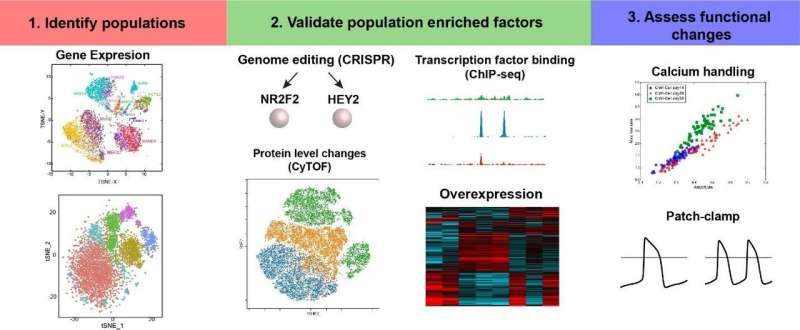Scientists identify cellular gene signatures for heart muscle regeneration

Repairing heart muscle damaged by a heart attack or other cardiovascular diseases is one of the "holy grails" for cardiovascular scientists. The ability to repair heart muscle—especially by using a person's own cells—would be a significant advance that could enhance quality of life for the millions of people who suffer from a heart attack or have a chronic heart condition.
Researchers believe that human-induced pluripotent stem cells (hiPSC) are the key to unlocking this regenerative ability. By taking a tiny bit of blood, scientists can generate an individual's patient specific stem cells and then convert them into any cell type in the body—including cardiomyocytes, the cells that make up the heart muscle. The research, however, is in its infancy and the technique is not yet ready to be deployed for human heart disease regenerative purposes.
Now, researchers at the University of Arizona are one step closer to understanding hiPSC cardiomyocytes and how they may better be utilized to repair heart muscles. In a study published this month in Nature Communications, Jared Churko, Ph.D., assistant professor of Cellular and Molecular Medicine at the UA College of Medicine—Tucson, used a systems-based approach encompassing single-cell transcriptomics, single-cell proteomics and CRISPR gene-editing to identify different subpopulations of cardiomyocytes.
Definitions:
- Transcriptomics is the study of the transcriptome—quantification of the types of RNA produced within the cell.
- Proteomics is the study of proteomes, the proteins expressed by a cell, tissue or organism.
- CRISPR gene editing is a technology for modifying an organism's DNA code at the single-cell level. This has the potential to correct cells that are known to cause a heart condition.
The research reveals multiple subpopulations of cardiomyocytes expressing specific transcription factors (NR2F2, TBX5 and HEY2)—with different spatial and biological functions as observed in the heart. Dr. Churko believes this new understanding of cardiomyocytes can be used to better repair heart muscle injuries in the future.
"Understanding the gene signatures of different populations of hiPSC-CMs will impact our understanding of how to use such cells to discover drugs, model heart disease and repair a damaged heart," Dr. Churko explained.
Dr. Churko's research team included scientists from Stanford University and the Cincinnati Children's Hospital Medical Center. Dr. Churko is associated with the Center for Innovation in Brain Science, an assistant professor of physiological sciences and genetics in the Graduate Interdisciplinary Programs, member of the Center for Applied Genetics and Genomic Medicine and the UA BIO5 Institute and director of the UA iPSC Core in the UA Sarver Heart Center.
The Nature Communications article is titled, "Defining human cardiac transcription factor hierarchies using integrated single-cell heterogeneity analysis."
More information: Jared M. Churko et al. Defining human cardiac transcription factor hierarchies using integrated single-cell heterogeneity analysis, Nature Communications (2018). DOI: 10.1038/s41467-018-07333-4



















